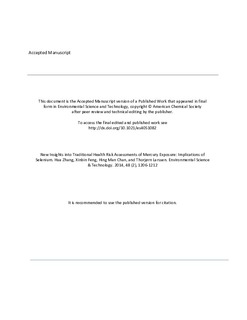| dc.contributor.author | Zhang, Hua | |
| dc.contributor.author | Feng, Xinbin | |
| dc.contributor.author | Chan, Hing Man | |
| dc.contributor.author | Larssen, Thorjørn | |
| dc.date.accessioned | 2018-10-23T10:17:59Z | |
| dc.date.available | 2018-10-23T10:17:59Z | |
| dc.date.created | 2014-05-06T13:16:02Z | |
| dc.date.issued | 2014 | |
| dc.identifier.citation | Environmental Science and Technology. 2014, 48 (2), 1206-1212. | nb_NO |
| dc.identifier.issn | 0013-936X | |
| dc.identifier.uri | http://hdl.handle.net/11250/2569086 | |
| dc.description.abstract | There is increasing evidence that selenium (Se) has a significant effect on mercury (Hg) toxicology; however, Hg exposure risk assessments usually consider only the amount of Hg present in the environment or in food. On the basis of the present understanding of mechanisms of interaction between Se and Hg, the physiology/toxicology of Se, and the toxicology of Hg, we propose a new criterion for Se/Hg exposure assessment. This criterion, which is based on Se–Hg interactions, considers not only the toxicological consequences of Hg exposure but also the benefits and/or adverse effects of Se intake, especially the adverse effects related to a Se deficiency/excess. According to an illustrative assessment based on the new criterion and nine existing criteria, large knowledge gaps in the traditional assessments of exposure to Hg and/or Se were found, including those that assessed the interactions between Hg and Se. These results suggest that future assessments of Hg exposure (or Se intake) should include both Se and Hg. | nb_NO |
| dc.language.iso | eng | nb_NO |
| dc.publisher | American Chemical Society | nb_NO |
| dc.title | New insights into traditional health risk assessments of mercury exposure: Implications of selenium | nb_NO |
| dc.type | Journal article | nb_NO |
| dc.type | Peer reviewed | nb_NO |
| dc.description.version | acceptedVersion | nb_NO |
| dc.source.pagenumber | 1206-1212 | nb_NO |
| dc.source.volume | 48 | nb_NO |
| dc.source.journal | Environmental Science and Technology | nb_NO |
| dc.source.issue | 2 | nb_NO |
| dc.identifier.doi | 10.1021/es4051082 | |
| dc.identifier.cristin | 1131443 | |
| dc.relation.project | Andre: Natural Science Foundation of China: 41203092 | nb_NO |
| dc.relation.project | Andre: National “973” Program of China: 2013CB430004 | nb_NO |
| dc.relation.project | Utenriksdepartementet: SINOMER | nb_NO |
| cristin.unitcode | 7464,30,12,0 | |
| cristin.unitcode | 7464,30,0,0 | |
| cristin.unitname | Akvatiske miljøgifter | |
| cristin.unitname | Fagsenter for ferskvannsmiljø | |
| cristin.ispublished | true | |
| cristin.fulltext | postprint | |
| cristin.qualitycode | 2 | |
